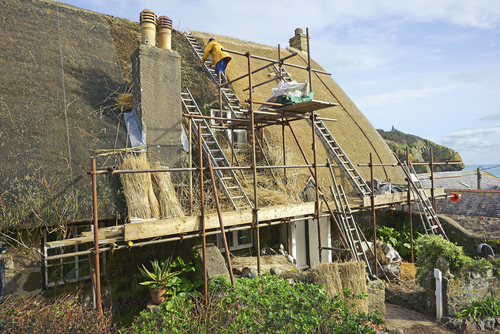“Yelming” is part of the thatcher’s trade: to yelm is to prepare the gathered straw, sorting it by size, laying it out flat, and in some techniques, dampening it with water.
According to James Arnold in his amazing book The Shell Book of Country Crafts (if you’ve read some of my other entries, you already know how much I love this book), the thatching trade is one of the few to remain virtually unchanged for the centuries, and into the modern age. A thatched roof is more than a fashion statement, it is a highly practical means of roofing a house. Furthermore, though the skills take time to master, the most effective tools for the job have never been more than the jack (a pronged fork for carrying bundles of material), the mallet, the leggat (a grooved board used to “coax home” the straw or reed), and the scythe–the last two being incorporated in the seal of Britain’s National Society of Master Thatchers:

In 1968, when Arnold’s book was written, there were between 700-800 working professional thatchers in Britain. This number was on the increase at the time, as there was a renewed interest in thatching, which had previously been in decline due to several factors. These included the booming slate roof industry and the advent of combine-harvesting of wheat (a process that destroys the wheatstraw previously used for roof thatching). To replace the wheatstraw, common reed (which had always been one of the materials of choice) was increasingly being systematically cultivated and harvested.
Today, that number remains roughly the same, with about 900 thatchers in Great Britain (and about 60,000 thatched roofs). According to the International Thatching Society, there are about 300 thatchers in Japan (with 100,000 thatched roofs), 1000 thatchers in Holland, and 400 in Denmark. Sweden, Germany, and South Africa also have a lively tradition of thatched roofing. Sadly, in the United States, the thatched roof remains a novelty, with a select few craftsmen (mostly transplanted from Europe) here to practice the trade.

Personally I’m fascinated by this craft that found its perfection so long ago, and has retained it for centuries. It’s beautiful in its simplicity and practicality, and I have nothing but respect for the hardworking and skilled tradesmen (and the homeowners who love their roofs) who keep it alive.
Featured photo: A traditional thatched roof (with solar panels), Altensien, Germany. Photo courtesy of Shutterstock.

I really like the roofing style. Looks like it’d be a pain to clean/maintain, though.
LikeLike
Thanks for the comment! According to the National Society of Master Thatchers, a thatched roof lasts about twenty years (depending on a variety of factors, including climate, quality of construction, quality of materials, and so on). Apparently, a well-made thatched roof does not require more maintenance than many other styles of roof. However, maintaining or repairing the roof is definitely not a DIY project!
LikeLike